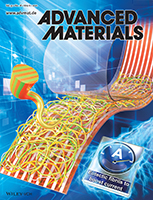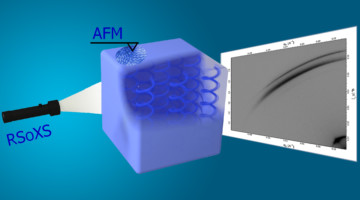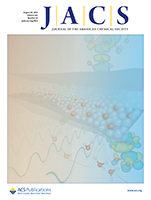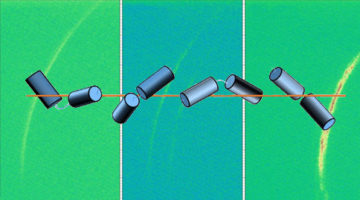Researchers report the fabrication of ternary organic solar cells, achieving a significant JSC boost, by virtue of their optimized crystalline feature, with the formation of eutectic crystalline fibrils. The optimal morphology suppresses energetic disorder and nongeminate recombination, and increases charge transfer and transport, yielding a high efficiency of 17.84% with significant current amplification. Read more »
Additive Lithography–Organic Monolayer Patterning Coupled with an Area-Selective Deposition
This scene depicts the layer-by-layer growth of an inorganic film in a selected area. The alternation of a chemical agent (blue) deposits on a gray substrate to form an inorganic film. A cross-linked organic material (tan) locally inhibits this reaction and prevents film deposition. Furthermore, the pattern-wise cross-linking of this organic film enables nanoscale pattern generation. Read more »
Efficient Organic Solar Cell with 16.88% Efficiency Enabled by Refined Acceptor Crystallization and Morphology with Improved Charge Transfer and Transport Properties
Feng Liu and co‐workers report a detailed structure‐performance relationship to help understand the success of Y6 non‐fullerene acceptors. Through the analysis of the single crystal structure of Y6, it is found that Y6 forms a polymer‐like conjugated backbone through its banana‐shaped structure and π‐π interactions between molecules, and forms a 2D electron transport network under the ordered arrangement of the lattice. Read more »
Multimodal Study of Ion-Conducting Membranes
Using multiple x-ray characterization tools, researchers showed how chemical and structural changes improve the performance of a novel ion-conducting polymer (ionomer) membrane from 3M Company. The work provides insight into factors impacting the proton conductivity of ionomers used for fuel cells and the production of hydrogen fuel. Read more »![]()
![]()
Multiple Levels of Chirality from Achiral Molecules
Liquid crystal samples were found to exhibit up to four levels of chirality, despite being made up of achiral molecules. The work sheds light on how molecular properties and competing interactions “propagate” order from the molecular level up to the microscale, leading to complexity similar to that found in biological materials. Read more »
Chemical and Morphological Origins of Improved Ion Conductivity in Perfluoro Ionene Chain Extended Ionomers
Resonant x-ray scattering and x-ray absorption spectroscopy with elemental sensitivity unravel structural features tied to water–ion domains and discern sulfur-containing groups in sulfonated ionomers, which help delineate chemical factors controlling their phase-separated morphology and governing ion transport. Read more »
Sulfur-linked cyanobiphenyl-based liquid crystal dimers and the twist-bend nematic phase
The synthesis and characterization of cyanobiphenyl-based liquid crystal dimers containing sulfur links between the spacer and mesogenic units are described. Resonant x-ray scattering studies of the twist-bend nematic phase at both the carbon and sulfur absorption edges were performed to determine the critical behaviour of the helical pitch at the transition to the nematic phase. Read more »
Linking Structure to Behavior in Twisted Liquid Crystals
Researchers untangled connections between structure and behavior in a class of liquid crystals consisting of flexible, chain-like molecules that self-organize into twisting patterns. The study opens up new possibilities for designing novel liquid-crystal molecules that allow greater control of nanoscale behavior for technological applications. Read more »![]()
![]()
Rational Optimization of Organic Solar-Cell Materials
Researchers have established a new quantitative model that connects molecular interactions in organic solar-cell materials to device performance. The work suggests a way to quickly identify ideal material mixtures and processing methods, bypassing trial-and-error strategies and minimizing labor-intensive synthesis. Read more »![]()
![]()
Twisted Structures Emerge from Achiral Molecules
The spontaneous formation of chiral structures from achiral molecules could shed light on the origin of biological homochirality—how one type of chirality dominated the other in certain biological molecules. Here, resonant soft x-ray scattering (RSoXS) has been used to explore helical phases that emerge from achiral asymmetric dimers. Read more »









